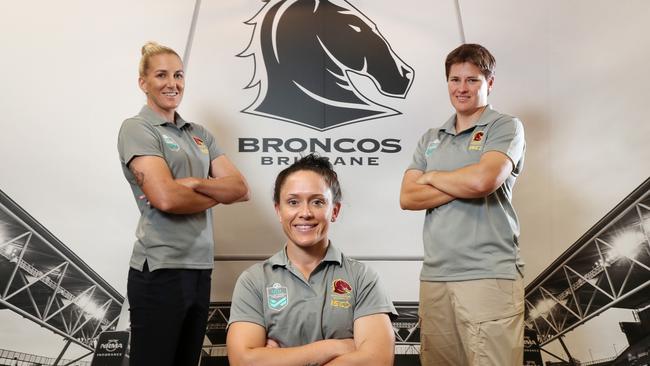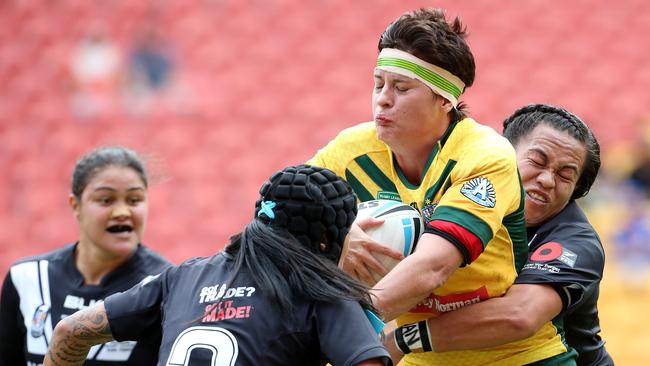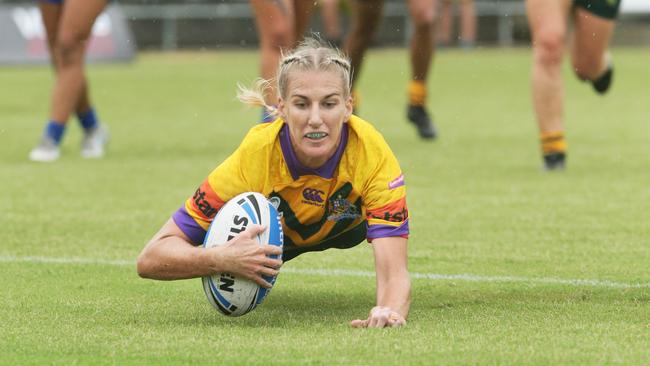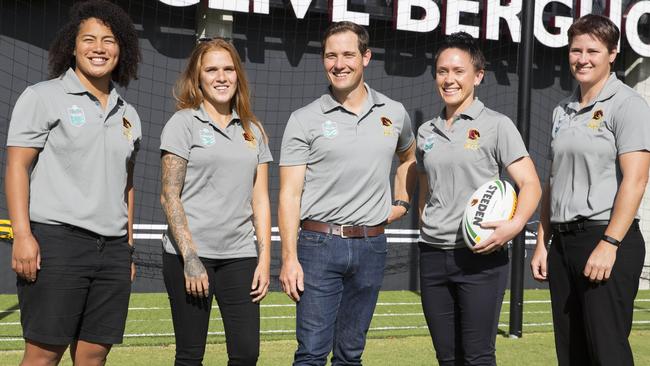Five reasons to care about new women’s NRL competition
NOT so long ago, girls had to give up playing rugby league at 13, and getting back onto the field was not easy. But the game has changed a lot - and is about to change even more.

Women's sport
Don't miss out on the headlines from Women's sport. Followed categories will be added to My News.
THE fast growing world of women’s rugby league made even bigger strides last week when the Broncos and Dragons signed their first players for the inaugural NRL premiership.
With the competition set to kick off in September, Brisbane announced the signings of Queensland and Jillaroos stars Brittany Breayley, Ali Brigginshaw and Heather Ballinger, as well as Kiwi Ferns powerhouse Teuila Fotu-Moala.

They also handed one of their 22 playing contracts to young Jillaroos half Caitlin Moran, who has been ruled out for the season with an ACL injury but has a big future.
Down south, the Dragons were the first team to have players put pen to paper, with Kezie Apps, Samantha Bremner, Talesha Quinn and Rikeya Horne all joining the club.
The remaining two teams, the Roosters and the Warriors, are yet to announce their first signings, but there is no doubt they will be rolling out some big names soon.
It’s a historic month for women’s rugby league, with the players also set to take part in their annual interstate clash on June 22, playing for the first time under the State of Origin banner.
To those on the outside, it may seem like just a simple and logical step forward for the women’s game and the NRL.
But these signings and the year ahead are massive for the athletes and their supporters.
Here are five reasons why this matters.
1. THE PAST
Women’s rugby league has burst onto the sporting scene over the past three years.
One of the biggest turning points was the inclusion of the Jillaroos and Kiwi Ferns at the Auckland Nines tournament, alongside all 16 NRL clubs.
From here, greater attention has been given to the interstate challenge between Queensland and NSW as well as the international game, culminating in a televised World Cup last year.
But there are many great athletes who have helped build the women’s game to this point that were never able to enjoy what today’s players are experiencing.
Names like Karyn Murphy, Tahnee Norris, Tarsha Gale, Nat Dwyer and Jo Barrett were massively influential on the growth of rugby league but are now long retired.

Queensland dominated the interstate challenge for 17 years straight, often playing at suburban grounds in front of a handful of supporters.
These players had to pay their own way to compete at the international level, selling their own cars to be able to do so.
As Broncos women’s coach and former Jillaroos assistant coach Paul Dyer describes it, they made major sacrifices for a game that few even knew existed.
“Ten years ago you would have never thought this would happen,” he said of the upcoming NRL premiership.
“Girls like Karyn Murphy and Tahnee Norris and those legends of the past, they used to pay $4000 and sleep in a scout hall for the privilege of playing for Australia.”
While the deserved acknowledgment of the players of the past may never come, these advancements will matter greatly to them. They laid the foundations for this to be possible.
2. THE PRESENT
Jillaroos prop Heather Ballinger grew up on a sheep and cattle station outside of Longreach.
There was no power on her property, so to be able to watch the Broncos she had to beg her parents to turn on the generator.
As of last Friday, Ballinger is now a Bronco herself.
“Right up until now I never ever thought there would be an opportunity for women to be playing at this level,” she said.
“When they announced the women’s premiership, I was just happy, excited and thrilled that we’d been given this chance.
“I get really emotional about it. It’s not going to really hit me until I put on the jersey and run out there and realise I am fulfilling something I’ve been chasing without knowing I was chasing it.
“I get the goose bumps and that shiver feeling that runs down your spine. That to me … shows my emotion and excitement towards being part of the Brisbane Broncos.”

Like Murphy and Norris before her, Ballinger has been part of some of the tougher years of women’s rugby league.
But now she will also get to experience the other side.
One of the top 40 NRL-contracted players, the Australian Federal Police officer will be paid for the first time to play the game she loves.
It is a dream come true for many of today’s players, particularly the older generation like Ballinger, Ruan Sims and Steph Hancock, who doubted this day would arrive.
For the younger generation, like Ballinger’s Brisbane teammate Teuila Fotu-Moala, this is the chance to set themselves up as pioneers of the women’s NRL competition and become stars of the game.
The Kiwi Fern will relocate from Auckland for the eight weeks of training and competition in August and September.
Nicknamed “The Jukebox” by Broncos great Darren Lockyer, because the “hits just keep on coming”, Fotu-Moala is embracing the chance to expand her rugby league skills in Australia.
“Knowing I will put on the same jersey (Lockyer) did, it’s a dream come true,” she said.
“It’s everyone’s dream to play in the NRL and it’s awesome we get the opportunity to do that too.
“The Broncos have been really supportive … just being here, it looks like I can be away from home for quite a bit. I love it here.”
3. THE FUTURE
The women’s game is the fastest growing area of rugby league.
In 2017, there was a 32 per cent increase in female participation across all age groups, more than 100 female-only rugby league competitions operating across Australia and more than 240,000 participants taking part in competitions and schools across the country.
Once upon a time, girls had to give the game up at the age of 13 and it was often difficult to take it up again in their early 20s due to limited opportunities.
We are talking about girls like Ali Brigginshaw, Karina Brown and Maddie Studdon, who were all part of Australia’s World Cup-winning squad.
But now the NRL, QRL and NSWRL are helping to build the right pathways so young girls don’t have to walk away from the game.
Brigginshaw, another who signed with the Broncos this week, said one of the most important aspects of this competition was showing aspiring female players that there is a way to the top.

“We’re the first Broncos team, so little girls will want to be just like us,” she said.
“Those times (playing as a kid) were hard but with the amount of support I did have from family and friends, it made me keep pushing.
“I looked at (the doubters) and thought, ‘yes, I’m the only girl but I’m going to prove I can play footy as good as the boys.’
“There will be little girls now that are the only girl at their club but they can see what we’re doing.”
4. MATCHING IT WITH OTHER CODES
Rugby league is not the only sport where female athletes are being thrust into the spotlight.
Cricket, soccer and Rugby Sevens are just a few sports producing big names across the country while the AFLW — introduced in 2017 — has had immediate success.
There were concerns the NRL may fall behind, but they are now matching it with the other codes as they should.
This will also prevent young girls from switching to other sports if they don’t see pathways or support.
The NRL have done well to place their inaugural premiership at a time of year where there will not be much other competition.
Kicking off in September, the women’s league will coincide with the NRL finals.
The four teams — Broncos, Dragons, Roosters and Warriors — will play their games as double headers with the men’s matches.
There will be a grand final at ANZ Stadium, also to be held as a double header with the men’s NRL final.
There will be no AFLW, W-League or Big Bash at this time.
5. EQUALITY
One of the biggest reasons these signings matter is to show that women are inching closer to equality with the men.
There is still a long way to go if the women want to be on par with the NRL’s best.
They have a lot to prove and there is no denying they will have to win fans over in a short space of time come September.
But to be paid as semi-professionals, to have access to physios, doctors and rehabilitation services, and to be seen as part of the same team as the male players is a huge step forward.
Ballinger has been defying expectations and preconceived ideas of women for years.
“I was brought up in an era where women in sport, especially a male dominated sport, weren’t seen or heard of or known,” she said.
“You hear comments like, ‘that’s not a sport for women’ or ‘why are you even playing that’, ‘when are you going to hang up your boots?’.
“You just learn to put that aside and focus on what it is you want out of it. That’s how I approached it and just chipped away at it.
“I was latecomer to rugby league (at age 22 in Cairns). We were never given the chance to play any football like that at my age or location.
“In Longreach we never had football or even touch. That was a male sport. Women played netball.
“I just did what I loved the most. Those comments and so forth, that’s in the back of my mind.”
Broncos women’s coach Paul Dyer hopes complete equality is not far away.
In the meantime, he will do everything he can to ensure his players feel part of the entire Broncos club and culture.

“If you’ve followed the women’s rugby league over the last 10 years, you would watch these girls, see how committed they are,” he said.
“They run in park football in front of two or three people and most of those people are their families that come and watch them.
“They’re just as committed as the men, they play the game just as tough as the men and I think for us as a code in the NRL and for us as a club in the Broncos to recognise that and finally put these girls forward and give them what they deserve, that’s a really important step into the future.
“Not too far into the distant future we may see our first full-time women’s rugby league players.
“To think in September they’ll play in front of big crowds and in big stadiums is really exciting.
“I get to hear the excitement on the end of the phone (when offering contracts) … I can only imagine what that’s going to be like when they pull on the jersey for the first time.”
Originally published as Five reasons to care about new women’s NRL competition
